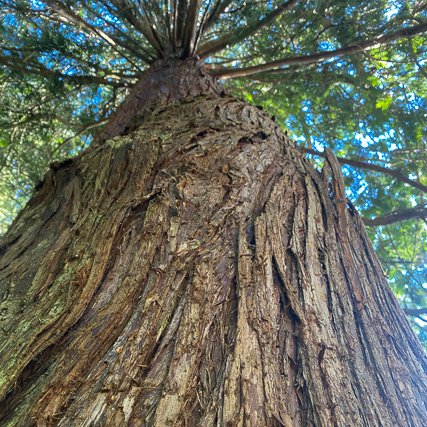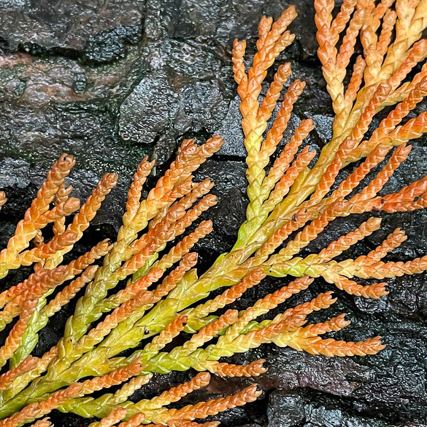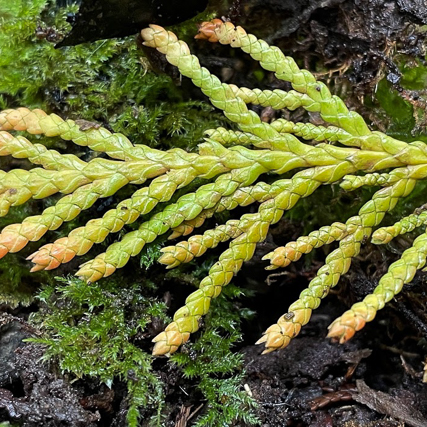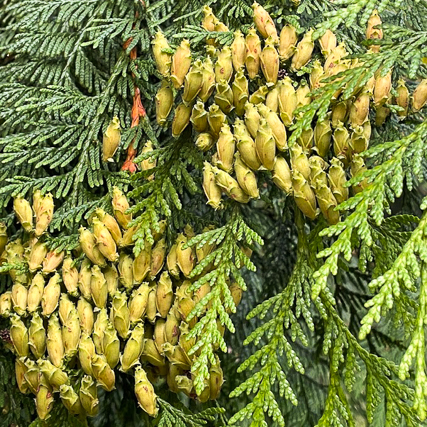fauntleroy tree walk
Western red cedar
Lushootseed Name:

Latin name:
Thuja plicata
Family:
Cupressaceae, the cypress family

Habitat
This species is found along the coast from Alaska to northern California, west and east of the Cascade Crest and in the Rocky Mountains of northern Idaho and Montana along the Continental Divide. Among this range, this species meets its prime habitat in the Olympic Peninsula of Washington state, with the oldest tree growing here at age 1400 years.Western red cedar relies heavily on moisture in the forests of the Pacific Northwest air and soil. They tend to be found in high rainfall areas and upslope of streams. Their spreading, surface root structure allows them to suck up more rainwater once it hits the forest floor.
Identification
growth habit
Western red cedar is a tree that can grow up to ~200 feet tall. Height of this tree species typically depends on the amount of sunlight available in its canopy.
leaves
Fern-like fronds that show a row of scale leaflets that give it a flattened braid-like appearance. The boughs of this tree have a J-ing shade as these fronds reach upward towards the sunlight.

flower
Fern-like fronds that show a row of scale leaflets that give it a flattened braid-like appearance. The boughs of this tree have a J-ing shade as these fronds reach upward towards the sunlight.

fruits
Small cones have a wooden-rose appearance. They open upwards in an almost “blooming” fashion.

bark
Brown-red with peeling bark that has a beef jerky appearance. If you peel the bark away, a brilliant red hue makes it clear where this plant gets its name.

look-a-likes
You might mistake this plant with yellow cedar, yet not a common issue in this forest. Yellow cedar boughs tend to lie limp, unlike Western red cedars, whose J-upward. Fronds are much more blue-grey in yellow cedar to that of green in western red cedar and the cones on yellow cedars look like a juniper berry. Yellow cedar’s grey bark appears to peel like that of western red cedar, but is much drier and flakes more than peels.
Ecology
Western red cedar does best in shady, nutrient-rich undisturbed soils. However, western red cedar is able to grow in nutrient-poor mineral soils created after forest fires, unlike many other species. This sets it apart from its common counterpart, western hemlock, who relies heavily on decaying organic material.
This tree typically adds calcium back to the soil, making the ground more fit for other species to grow. The understory of western red cedar tends to be home to Oregon grape, sword fern, huckleberry, and salmonberry patches to name a few. Western hemlock has a unique canopy with upward facing branches that make an “armpit” for epiphytes, or plants who can grow on the water and nutrients of other plants. Western red cedar harbors nooks of western hemlock and salal.
This tree puts out many, small seed cones due to the fact that many seedlings are eaten by forest rodents and birds. Many lasting western red cedar trees are the result of “vegling” growth. This type of growth results from branches completely breaking and falling, splitting, or drooping and hitting the ground where it takes root and forms a new tree. Small mammals burrow in its cavities and black bears take refuge in trunk dens.
This species’ roots are deeper than that of hemlock, but shallower than that of Douglas fir. This species has antifungal properties in its bark, protecting itself against fungal rot in this moist environment.
Ethnobotany
The “tree of life” has been used for everything ranging from medicine and clothing to houses, canoes, and totem poles. The fiber of this tree has a strong and stringy texture, and is waterproof, making it great for sewing into skirts, hats, capes, and more! This soft fiber is also used to line cradles, in making towels, and in sanitary pads.
Western red cedar is a spectacular vessel for water and food in the form of baskets and bentwood boxes. Bentwood boxes held foods and oils and were even used to cook in.
Cedar planks were used to build large longhouses that shelter Coast Salish peoples throughout wet and snowy winters. Uses extended beyond the land and onto the sea in the form of canoes, in weaving rope that would tow whales home after big hunts, and making rakes for harvesting herring eggs.
It is used as a medicine for toothache, lung and kidney issues, colds, and fevers. Western red cedar was present everywhere in the life of first nations people. This tree is so powerful in the Coast Salish culture, it is believed that when someone strong and helpful passes, they come back as a Western red cedar to continue to help their people.
It is worn in ceremony and by whalers before they go off to a dangerous hunt. This tree is the life blood of this region’s people. First nations people take from this tree in a sustainable manner, where they harvest minimally from the tree in a way that allows the tree to survive.
Western culture has harvested and removed ancient stands of this species leaving only few to survive and carry on a centuries long legacy.
